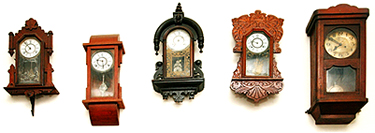A row of empty studios greeted me.
It was as if the Christmas break had come early to my alma mater - the National Institute of Design (NID). The rows of studios were buzz of activity when I was a student there some dozen years ago. The open studios partitioned by plywood sheets of around 4 feet would be home to many throughout the day and often late into night.
Not any more, says Tarundeep Girdhar, my host and the co-ordinator of Graphic Design Studies at the NID. Remember the enlarger? A medieval device that would gobble us up as we entered its guts and tried to enlarge the drawings via a series of old-world reflections...
The studio was the hub of all activity - a place where we would draw, sketch, colour, cut, argue, review, critique. This was a place where revered (or hated) seniors would pass by, look over the partitions and offer insights, feedback and criticism. As would visiting faculty and the full timers. The drawing teacher could comment on logo design and vice-a-versa.
In the last week of November, I came to NID (after almost a decade) for the open juries - one of the evaluation method used to test students at the end of the semester. And by the end of day one, almost 9 hours of sitting through presentations - one thing was clear, there wasn't sufficient critiques happening on a weekly level. Context wasn't being clearly set for many of the theoretical briefs. Several student responses lacked the maturity or their very own perspectives that should reflect in the work of the particular year.
On day 2, it became evidently clear that far too many students were spending far too much time sitting in their rooms, glued to laptop screens, their interaction mediated by mobiles or sites like facebook. No wonder the studios were sparse. The revered, hated or even apathetic senior were missing as were wide-eyed wonder struck juniors. I had a chat with a group of students later that night, well past their dinner time. Most of the group seemed to agree with my observation - they were spending far little time in the studios chatting, arguing (and drawing/cuting and pasting in the real world in real time) and most importantly learning from each other and their peers. My furniture designer friends would have a point of view on the poster. Over cups of chai we would agree, or agree to disagree - and each would leave a little more enlightened (or corrected).
Real world interaction around a real printed or prototyped piece of work can not only help shape opinions and issues around the particular piece but also about design practice in a broader sense. Watching and participating in critiques is a surefire learning experience that stays well beyond the few hours that could be put in every week.
As I left Ahmedabad the following morning early, I couldn't help but think of all those who shaped my opinion about design - through examples of delightfully good, sheer bad and utterly ugly work. My classmates, the seniors, the many visitors who passed through and commented on work, the juniors and of course my teachers.
The challenge: how do we introduce the digitally connected generation to the real classroom and help them each find their own opinionated pathways through the richly layered world of design?
 Above: Student Yash Misra's visualisation of his social networks is a fascinating study into the multiple platforms via which students interact at NID.
Above: Student Yash Misra's visualisation of his social networks is a fascinating study into the multiple platforms via which students interact at NID.





7 comments:
Indeed a challenge, but without inspired/inspiring faculty who recognise this gap it will only get increasingly difficult. By the way JD what is NID doing about faculty training as of today? Does it still intend to thrive on misfits (harsh but true) and "have nothing else to do, so may as well"s, to fill the gap?
Interesting. I think I was there the very next day (for just an hour) and yes I did sense a similar thing. Then I thought well ... things ARE different now. Tightening the course into a 4yr capsule sort of tends to make things more end-oriented so the debates with furniture design mates became less important. We used to languish a lot more 14 yrs ago :)
Also facebook and the laptop are there ...they weren't when we were ... so I can understand that there will be an automatic tendency to embrace these.
But yes REAL interaction does have a lot of merits that can never be replaced by the online or digital exchanges - I am saying that imagine ;). What can we do about it? Well should be easier in a place like NID.
Structure a course or a workshop that doesnt require internet or research ... or is centered around exchanges, interactions .. open it up to the whole community. Do it at a scale that it leaves a significant impression on the whole community. And hope that they keep trying to use similar methods in all their other courses, I guess ;)
I have personally been toying with education in design for technology and have been thinking of social media classrooms.
I agree that there are unmatchable merits if the student can see me face to face (as I squint at at an appalling attempt at Carson-ian typography). Considering that is not possible we can create social media classrooms that help tutors from all over interact with students at near-time rather than real-time.
I recently read an excerpt from an interesting book called Disrupting Classroom (http://www.amazon.com/Disrupting-Class-Disruptive-Innovation-Change/dp/0071592067). I guess this book reinforces the social media classroom thought a lot more.
If Tarundeep is interested he could join this new movement - http://socialmediaclassroom.com/application/webform/application-join-social-media-colab-community
For a start we can try it with a small bunch in a closed group within facebook. I am all game.
Its is not necessary for good designers to be good teachers. It surely takes much more than that and early NID managed to nurture a generation of design teachers who were passionate about teaching and could inspire. If we are talking about dragging students off from their facebook and laptops (which are here to stay) back into the studios, it will definitely take some extraordinary teachers to get their attention.
yes of absolute interest. and share your sense of regret and loss.
however, i'm afraid i don't see technology as a substitute for experience - no matter how engrossing. nor did i find yash's visualization fascinating. this obsession with making invisible patterns visible is getting a bit too much i think. beyond a point, what to do with so much data?
warn me if i'm beginning to sound like a cranky old man, but perhaps it's the finnish winter (wet/cold/6-hour day) that's getting to me!
love/arvind
I apologize. I think my comment was a bit too scrambled. My point was to make the students' digital interactions a little more meaningful. Take the classroom to the student than the student to the classroom.
Again, this is not to substitute real classrooms. But you can get the feedbacks and the critiques home.
On a related note, how many of use our hands to create pieces of work today. So how important is that grandad enlarger and similar totems around which you exchange thoughts.
Thank you Sanjay, Pooja, Shiva and Arvind. Some very interesting points and some good constructive suggestions. The key questions are how do we use technology so that it becomes a constructive, learning tool - not just a for shallow 'chit-chat'.
Frfom Tarun et al, I could get a sense that there aren't enough teaching resources or not of the experience NID would have wanted. Lot of people prefer lucrative careers outside or there is competition in form of other design schools (as employers).
I believe Ranjan is doing some interesting stuff in harnessing technology and using the tools of the trade for discussing and sharing. Shiva, some of your links I am sure will be of great use.
Arvind, I can understand your fatigue with data visualisation. It reminds me of Mark O'Brien, who once told me that if he sees another of those Maslows' Hierarchy of Needs in Masters Dissertations - he would seriously consider failing the student!
Post a Comment